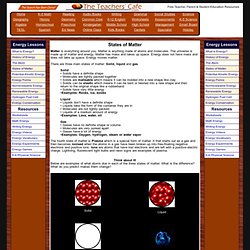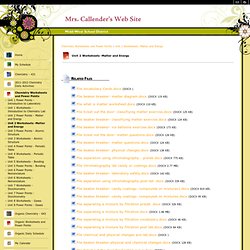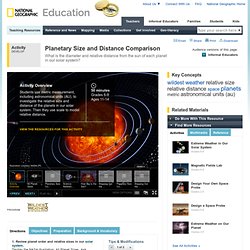

Materials and their properties Science Revision - Games and Activities. States of Matter: Solid, liquid, gas, plasma. Elementary Science Lesson, games, vidoes, worksheets. Matter is everything around you.

Matter is anything made of atoms and molecules. The universe is made up of matter and energy. Matter has mass and takes up space. Energy does not have mass and does not take up space. Energy moves matter. There are three main states of matter: Solid, liquid and gas. The fourth state of matter is Plasma which is a special form of matter. Think about it! Below are examples of what atoms due in each of the three states of matter. Schools Science Clips - Changing state. Unit 2 Worksheets -Matter and Energy. Chemistry Worksheets and Power Points » Unit 2 Worksheets -Matter and Energy File Vocabulary Cards.docx (DOCX ) File beaker breaker- matter diagram.docx (DOCX 119 KB) File what is matter worksheet.docx (DOCX 110 KB) File ticket out the door- classifiying matter exercise.docx (DOCX 125 KB) File beaker breaker- classifiying matter exercise.docx (DOCX 124 KB) File beaker breaker- ice balloons exercise.docx (DOCX 173 KB) File ticket out the door- matter questions.docx (DOCX 126 KB)

Class Page - hostettersciencecs. Science Fair ProjectsThe Ultimate Science Fair Project Resource! Questions & Answers on Science Fair Projects! Sample Science Fair Projects! Science Fair Project Ideas! Good Links on Elementary Science! Hundreds of Good links for Science! Atoms, Mixtures, & Molecules (Matter) Matter Study GuideDownload PowerPoint on Atoms, Matter & Molecules! Living Systems (Plants & Five Animal Kingdoms Living Systems Study GuideDownload Invertebrate PowerPoint! Cells Cell Study GuideDownload PowerPoint on Cells! Labeled Plant & Animal Cells! Earth (Rocks & Volcanoes) Earth Study Guide4th Grade Soil Study Guide! Force, Motion, and Energy (Force) Force, Motion & Energy Study GuideDownload PowerPoint on Energy (Force)Another PowerPoint on EnergyGood Energy Links & Worksheets! Light Light Study GuideLight Presentation, Worksheet & Test! Water & Oceans Ocean Study GuideExcellent Ocean Picture Learning!
Plate Tectonics. Planetary Size and Distance Comparison. 1.

Review planet order and relative sizes in our solar system. Display the NASA illustration: All Planet Sizes. Ask students to point out the location of Earth. Then challenge them to identify all of the planets, outward from the sun (left to right): inner planets Mercury, Venus, Earth, Mars; outer planets Jupiter, Saturn, Uranus, Neptune, and Pluto. Remind students that Pluto is no longer considered a planet in our solar system; it was downgraded to the status of dwarf planet in 2006. 2. What do you notice about the size of the planets? Have students discuss the answers in their small groups. 3. 4. 5. Sun: stands at the edge of the areaMercury = 1 step from sunVenus = 2 steps from sunEarth = 2.5 steps from sunMars = 4 steps from sunAsteroid belt = 8 steps from sunJupiter = 13 steps from sunSaturn = 24 steps from sunUranus = 49 steps from sunNeptune = 76 steps from sunKuiper belt = 100 steps from sun.